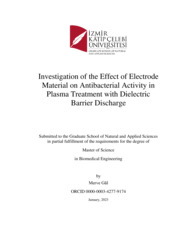Investigation of the Effect of Electrode Material on Antibacterial Activity in Plasma Treatment with Dielectric Barrier Discharge
-
Eser Sahibi
Merve Gül
- Tez Danışmanı UTKU KURSAT ERCAN
-
Tür
Yüksek Lisans
- Yayın Tarihi 2023
-
Yayıncı
İzmir Katip Çelebi Üniversitesi Fen Bilimleri Fakültesi
- Tek Biçim Adres https://hdl.handle.net/11469/3373
-
Konu Başlıkları
Soğuk Atmosferik Plazma
Plazma Tıbbı
Plasma is an ionized gas generated under an electric field that contains photons, free electrons, ions, free radicals, and reactive oxygen/nitrogen species (RONS). Cold atmospheric plasma (CAP) is generated in the cold form under a high electric field at atmospheric pressure. CAP is generated using two methods, Dielectric Barrier Discharge (DBD) and plasma jet. In the DBD method, the electrode configuration, shape, material, and substance from which the dielectric barrier is made are important. Beyond the electrode design and geometry, the barrier and electrode materials can also impact the reactivity of the discharge by modifying the discharge electrical power. Plasma discharge at various durations in CAP applications is hypothesized to alter because of a difference in conductivity of the conductive material utilized depending on capacitive resistance and permittivity. Therefore, in this study, plasma activated waters (PAWs) are evaluated using three alternative electrode materials (copper, stainless steel, and aluminum) to quantify physical quantities that can differ significantly such as RONS levels, pH, and RONS types. The study aims to investigate the effect of the antibacterial activity of CAP treatment using different electrode materials on microbial inactivation of E.coli and the biological outcome of CAP treatment on skin cells. The results revealed that the difference in electrode materials affects the amount of, RONS, pH, and antibacterial activity in CAP treatments, the electrode material with the highest antibacterial activity was observed to be stainless steel according to ZOI results. The results of the antibacterial activity of CAP treatment were divided into groups; direct treatment and by PAWs. According to the colony counting results, it can be said that the aluminum electrode is the most effective group for antibacterial efficacy on E.coli. Therefore, the aluminum electrode has the highest cell proliferation effect compared to others with respect to cell viability assay results. By adding one more parameter to which factors are important in antimicrobial experimentations in the field of plasma medicine, this research will carry light on iv future studies and which RONS types are more effective for required microbial inactivation.
-
Koleksiyonlar
ENSTİTÜLER
FEN BİLİMLERİ ENSTİTÜSÜ

 Tam Metin
Tam Metin

